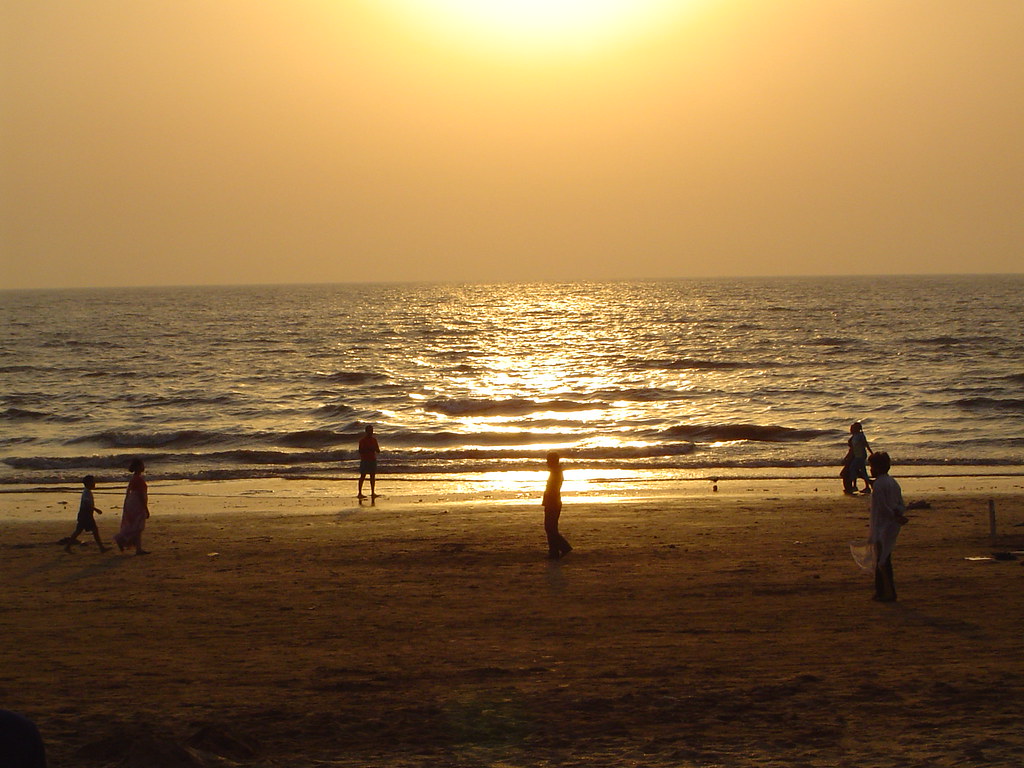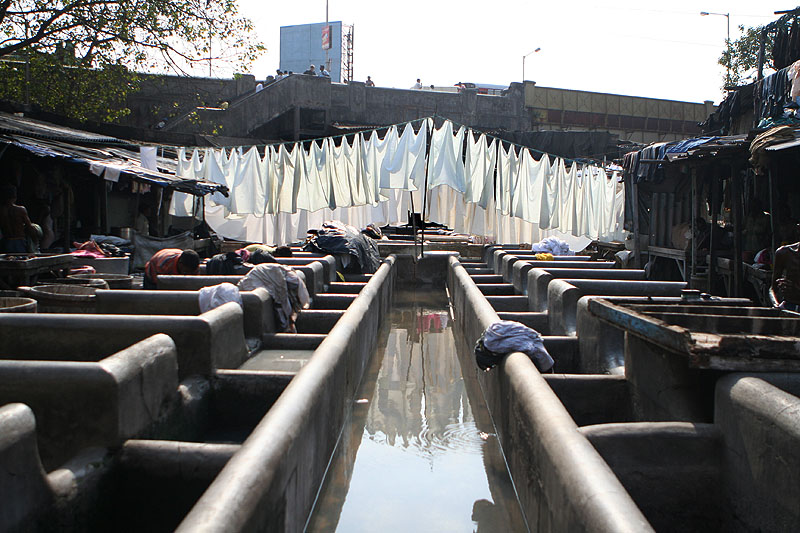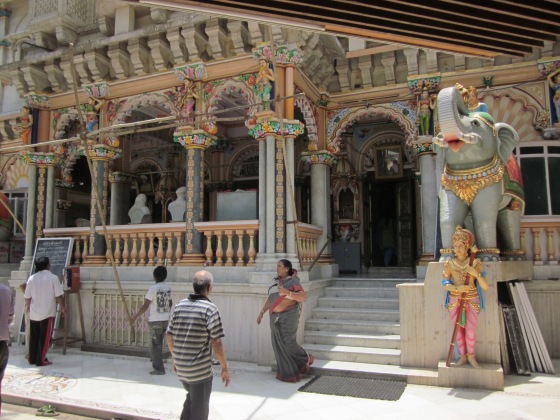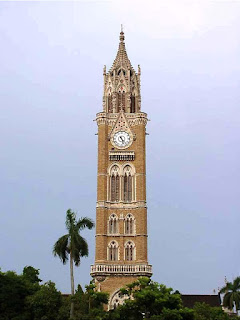
Mumbai is what the Indians affectionately call – the ‘City of Dreams’. This fabulous city is not only the financial capital of India that serves as the center of all trade and investments, but also a cultural center. Mumbai is where you can possess the most distinguished designer labels and products from various fashion houses that flood the busy malls. This is the one place where glamour is not an uncommon word and is reflected ostentatiously in the Bollywood film industry. Take a look at the beaches in Mumbai to witness some of God’s amazing miracles- the magnificent sunsets over the Arabian Sea, which is a dream-like vision. In Mumbai, night is when the day truly begins, which is why Mumbai is also referred to as the ‘city that never sleeps’.
Must Visits :
- Gateway of India
Mumbai’s most recognized monument, the Gateway of India was constructed to commemorate the visit of King George V and Queen Mary to the city. Designed to be the first thing that visitors see when approaching Mumbai by boat, the looming Gateway was completed in 1924 and remains as a striking symbol of the British Raj era. Its architecture is Indo-Saracenic, combining Islamic and Hindu styles.
- Heritage Buildings
Mumbai has some captivating heritage buildings where you can marvel over staggering examples of intricate colonial architecture. Some of the best are the Gothic looking Prince of Wales Museum in the Kala Ghoda art precinct, Victoria Terminus (CST) railway station, the Bombay High Court and the buildings of Horniman Circle in the Fort area. Also have a wander past the historic 18th century homes in Khotachiwadi village.
- The Asiatic Society
The Asiatic Society of Mumbai, a learned society in the field of Asian studies, is based in Mumbai, India, was completed until the year 1830.The library of the Society has over a hundred thousand books out of which 15,000 are classified as rare and valuable. It also has priceless artifacts and over 3,000 ancient manuscripts in Persian, Sanskrit and Prakrit, mostly on paper but some on palm leaf. The numismatic collection of 11,829 coins includes a gold coin of Kumaragupta I, a rare gold mohur of Akbar and coins issued by Shivaji. Its map collection comprises 1300 maps.
- Kala Ghoda Art Precinct

Kala Ghoda, meaning “Black Horse” in reference to a statue that was once located there, is Mumbai’s cultural center. This crescent-shaped stretch is home to Mumbai’s best art galleries and museums. It’s also filled with cultural spaces, including some wonderful pavement galleries. Stroll around at leisure, but be sure to visit the acclaimed Jehangir Art Gallery. Every year in February, the Kala Ghoda Association hosts a nine day Kala Ghoda Arts Festival, which is interesting.
· Markets and Bazaars
From the multitude of colorful pavement vendors that line Colaba Causeway, to the fascinating Chor Bazaar , Mumbai is full of interesting places to go street shopping. Stock up on attractive souvenirs at Colaba Causeway, delight in cheap shoes and clothes at Linking Road, scour the narrow alleyways of Chor Bazaar for antiques, and sample the fresh food and spices while marveling at the architecture of Crawford Market.
· Juhu and Marine Drive Chowpatty Beaches
At the end of a tiring day, relax on the beaches of Juhu and Marine Drive, and watch the sunset.
· Mahalaxmi Dhobi Ghat
This massive open air laundry provides an unforgettable glimpse into the inside of the city. Dirty laundry from all over Mumbai is brought here and painstakingly hand washed by the dhobis (washermen) in the seemingly endless rows of concrete troughs. The thousands of dhobis spend hours every day standing up to their knees in water filled with chemicals, manually scrubbing and beating the dirt out of each item of laundry.
· Mumbai Dabbawalas

Dabbawala, meaning a person who carries a container, is the term given to the thousands of men responsible for transporting and delivering around 200,000 lunch boxes of freshly cooked food to the city’s office workers every day.
· Haji Ali Dargah
The imposing Haji Ali is both a mosque and tomb. It was built in 1431 by wealthy Muslim merchant and Sufi saint Pir Haji Ali Shah Bukhari, who was inspired to change the course of his life after going to Mecca. It also contains his body. Situated in the middle of the ocean, Haji Ali is only accessible during low tide from a narrow, 500 yard long walkway.
· Caves and National Park
In contrast to its millions of inhabitants and sprawling development, Mumbai has a national park located within its limits. It’s worth a visit just to see the many ancient Buddhist caves, which have been hand carved into volcanic rock there. More caves, dedicated to the Hindu Lord Shiva, can also be found on Elephanta Island.
· Prince of Wales Museum
Formerly the Prince of Wales Museum, Mumbai’s primary museum is now officially called the mouthful Chhatrapati Shivaji Maharaj Vastu Sangrahalaya. The Prince of Wales Museum was named after the Prince, and future King George V himself, who laid the foundation stone of the building in 1905. The magnificent multi-domed building was designed by the same Scottish architect responsible for the Gateway of India, George Wittet, who successfully blended Gothic, Islamic and Hindu architecture. The museum houses a rare collection of mostly Indian artefacts.
· Victoria Terminus
Building started in 1878 and was completed 10 years later, although it opened for passengers in 1882. It is considered the most impressive example of Victorian Gothic architecture in all of India. Although it was renamed Chhatrapati Shivaji Terminus (CST) in 1996 many people still refer to it as VT. In 2004 this beautiful building was declared a Unesco World Heritage Site.
- The Taj Mahal Hotel

Taj Mahal is one of the most expensive hotels in Mumbai. This luxurious 5-star hotel was built by the wealthy Indian industrialist Jamsetji N Tata in 1903. The Tower block was added in the 1970s. In November 2008 The Taj Mahal Palace was only one of many places that were struck by shooting and bombings in an coordinated attack across Mumbai by terrorists.
- Bollywood – Mumbai’s Hollywood

Mumbai is home to Bollywood, the largest film industry in the world. Bollywood produces over 1,000 films a year. The Bollywood stars are hugely popular and the gossip columns follow their every move.
- Mani Bhavan – Gandhi House
.jpg)
Whenever Gandhi was in Mumbai – between 1917 and 1934 -Mani Bhavan was his headquarters. It was from here that Gandhi initiated several important movements that included Civil Disobedience (that led to the end of the British rule), Satyagraha (nonviolent protest), Swadeshi, Khadi and Khilafat movements.
On the second floor you will see the room where Gandhi worked. It has been well preserved in its original setting. The terrace where Gandhi slept and held prayers has a bronze plaque that marks the spot where Gandhi was arrested in 1932. The amazing library holds 50,000 books, many by or about Gandhi. The picture gallery has various photos of Gandhi and letters written by him.
- Sanjay Gandhi National Park
The park is on the North-end of Mumbai, and it is also known as the Borivili National Park. It’s a huge green haven surrounded by the continuously bustling city. The park offers numerous attractions, such as tiger safari, lion safari, train ride, hiking-trecks, tree-house, and best of all the caves.
- The Jain Temple, Walkeshwar
Jainism arose in Eastern India 500 years before the birth of Christ under the influence and teaching of Mahavira . Although it shares many of the tenets of Christianity and other religions like : non-violence, chastity, truthfulness, rejection of worldly/material pursuits and respect for the property of others – the overall philosophy and practices have important differences. Jains have reverence for life in all its forms that not only makes them vegetarian but also careful never to harm the smallest creature, even accidentally. There was an atmosphere of great calm and tranquillity in the temple. The ceiling depicted the signs of the Zodiac.
- Rajabhai Clock tower
A landmark in Bombay since its completion in 1878, the Gothic revival Rajabai Clock Tower is part of the University of Mumbai campus. The tower was financed by a wealthy local stockbroker and cotton merchant, Premchand Roychand, who named it after his mother Rajabai. The tower rises 78 metres and dominates the skyline over the Oval Maidan park.
- Nehru Planeterium
A little bit of a strange looking building which has been described as a corncob, this building, known as the Nehru Centre, houses the planetarium, concert or movie auditorium and convention centre. The centre has expanded into a centre for scientific study of astronomy. Scientists and scholars regularly meet for lectures and discussions to discuss the various astronomical events. Special programs are also designed for students. There are telescopes installed outside the Planetarium for visitors to use.
- Siddhivinayak Temple
One of the most impressive Hindu temples in Bombay, the Shree Siddhivinayak Ganapati Mandir traces its roots to 1801. It is dedicated to the popular Lord Ganesh (also called Ganapati), who has the head of an elephant, and is one of the most frequented temples in Bombay. The enormous modern structure was only built in 1994, as an annex to the original temple, in a unique architectural style drawing great inspiration from traditional Hindu temples. Due to the popularity of the temple, particularly among high profile celebrities and politicians, the temple was able to afford such a large scale enlargement to accommodate its growing followers.
- Monetary Museum

This is the one stop shop for all your questions on the history of currency. Apart from valuable artefacts like coins used by Tipu Sultan, the museum also showcases information on our current currency.
- Mount Mary’s Church
This 100 year old church is a striking feature of the hip suburb Bandra. This sea facing building is located near the Bandstand promenade and was constructed in honour of Saint Mary, who was believed to have healing powers. September is the best time to visit, since the Feast of Saint Mary takes place then and is celebrated in the form of the Bandra Festival, during which the whole suburb bears a festive look with shops and eateries set up all along the streets.
- National Centre for the Performing Arts

Started in 1969, it is India’s best known performance art institute which showcases the best in theatre, film, music and dance.
Performing art connoisseurs can indulge at the library which has a collection of over 20,000 books related to art, film, theatre and culture. There is also a collection of 5,000 audio recordings of Indian classical, Hindustani and carnatic music in the audio archives of the library.
- The Global Vipasana Pagoda

This state of the art pagoda which opened in 2009 was built keeping the aesthetic of a Burmese pagoda in mind. It is the world’s largest structure with no pillars, also the only one which houses Buddha’s relics in the tomb.
- Bandra-Worli sea link
This complex engineering marvel connecting Bandra to Worli was opened in 2009 and is India’s first cable-stayed bridge constructed over open seas. Drive down this eight lane bridge and the travel time from Bandra to Worli is reduced from 45 minutes to mere 10 minutes.
- Maharashtra Police Headquarters (Sailors’ Home)
The Maharashtra Police Headquarters moved into what was known as the Royal Alfred Sailors Home, constructed in 1876, in 1982.
- University of Mumbai

Established in 1857, the University of Mumbai was one of the first three universities in India. Its architecture is Venetian Gothic inspired.
- Banganga Tank
An ancient water tank that’s one of the oldest surviving structures in Mumbai. It dates back to 1127 AD, to the time of the Hindu Silhara dynasty.
- Bombay Stock Exchange
A prominent example of contemporary architecture in Mumbai, the current Bombay Stock Exchange building was constructed during the late 1970s.
- Prithvi Theater

An intimate theater auditorium, built in 1978, and dedicated to being a catalyst for theater in Mumbai.
- Mumbadevi Temple
The Mumbadevi Temple is dedicated to the goddess Mumba, whom the city of Mumbai was named after, and that’s what makes this temple noteworthy.
- Babulnath Temple
This ancient temple, devoted to Lord Shiva in the form of a Babul tree, sits 1,000 feet above sea level.
- ISKCON
The complex’s marble temple is apparently one of India’s most beautiful Krishna temples. Its walls are adorned with delightful murals and sculptures.
Cuisine
Mumbai is a cosmopolitan city known for its many lip-smacking dishes. Be it vegetarian or non-vegetarian, the dishes in Mumbai boast of rich taste, fieriness and impressive flavors. The cuisine of Mumbai covers a large assortment of interesting, authentic dishes and zesty seafood dishes. The staple foods consumed by the residents of Mumbai include rice, aromatic fish curries, Indian bread (chapatis and rotis), vegetable curries, pulses and desserts. Coconuts, cashew nuts, peanuts and peanut oil are some of the major ingredients used in many of Mumbai’s traditional dishes. Mumbai houses many restaurants where people can enjoy some amazing food. The city is known for its delectable chaats at the various food stalls in the busy streets of Mumbai. Here, the stalls are crowded with people who relish tangy fast-food and local snacks. Apart from the traditional dishes, chaats, sweets and seafood specialties, there are lovely continental restaurants across the city that will cater to a more subtle palate, if you can’t handle all the hot food!

Some of the well-known tourist attractions in India are found here in Mumbai. If you like water theme parks, then you must visit ‘Essel World and Water Kingdom’ for a day of complete adventure. Take part in the massive festivities of ‘Ganesh Chathurthi,’ and fulfill your dreams with the blessings of ‘Lord Ganesh’. Explore this extraordinary city and take home an unforgettable, typical ‘Mumbai’ experience. See it to believe it!
– HINAL SHAH



















.jpg)




103 Comments